| | | 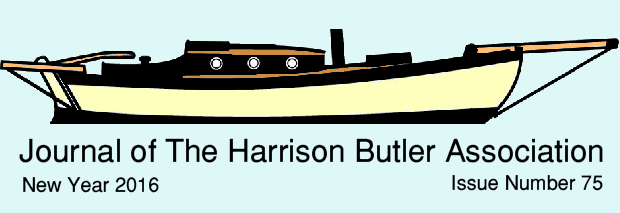
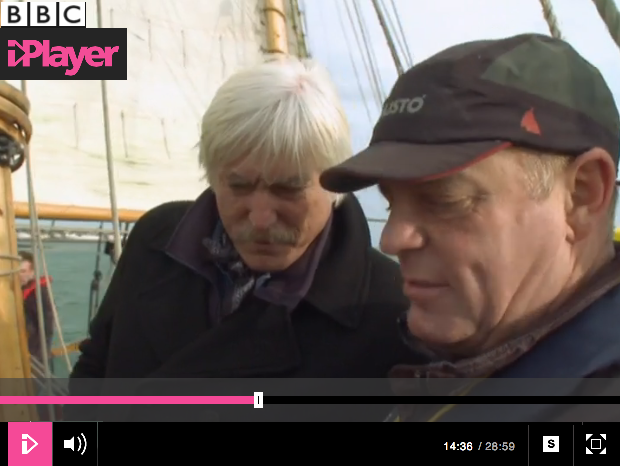
Tom Cunliffe, left, who's daughter Hannah Matthews is a custodian of Little Kingfisher,
introduces Craig Nutter, right, custodian of Sabrina, as
“The man who knows more about sailing fast than anyone else I know”
in the second episode of the six-part documentary series 'The Boats That Built Britain'.
The Journal of The Harrison Butler Association
Editor : Martin Hansen
Proof Reading : Dr Helen Jones
Far East Correspondent : Dr Stephen Davies
Australian Correspondent : David Stamp
Netherlands Correspondent : Michiel Scholtes
Baltic Correspondent : Myriam Spicka
UK Correspondent for The Solent : Robert Griffiths
UK Correspondent for Dartmouth : Allen Clarke
Contributions for the Journal are most welcome be they
fully formed articles, rough notes or snippets of News.
If you feel you would like to contribute on a regular basis,
applications to join our growing network
of correspondents are also invited.

My first summer afloat, 2013, was tainted by engine trouble. Unaware that problems lurked in the diesel supply, I'd had a four day, three night non-stop sail westward along the English Channel from Dover to Torbay powered by a steady force 4 Easterly wind. When I called upon Tramontana's engine to power her into Torquay marina it struggled; misfiring, knocking, and cutting out twice. In the harbour chandlery, I requested details of local mechanics. The owner looked at me sagely and advised, “The two main causes of engine trouble on boats are, firstly, dirty fuel and, secondly, dirty fuel”.
He was right. I had diesel bug. Probably from a 10 litre can of old 'emergency fuel' that had come with the boat and which I, not knowing any better, had used. I thought I'd bought a sailing boat in order to sail, but quickly realised that the so called auxiliary engine is essential when it comes to manovering a hefty wooden boat around a crowded marina.
In the two years since, I've routinely added a strong dose of Marine 16 Diesel Bug Treatment mid-way through a fill up. This removes already established diesel bug cultures. I use white diesel bought from a busy garage, knowing that it will not have been hanging around in the forecourt petrol pump for long. This I transport to Tramontana in 10 litre cans, each of these already containing a teaspoonful of Marine 16 Diesel Fuel Complete. This prevents diesel bug forming in the first place.
Tramontana's engine now runs beautifully but I remain concerned. The RNLI recently observed that many call outs are to pleasure craft with engine problems. The use of bio-fuel is increasing the likelihood of water being absorbed into the fuel from the atmosphere. So I've decided to go further and install a £300 MarShip's Marine Fuel Purifier. This removes water and sludge from up-steam of the first fuel filter.
Most of the time, engine failure is simply annoying, but I have been in situations where a sudden loss of engine power would most likely result in damage and insurance claims. Given that the auxiluary engine is, for most of us, an essential part of modern day boating, it makes sense that it be as robustly reliable as is practical. And that starts with a clean fuel supply.
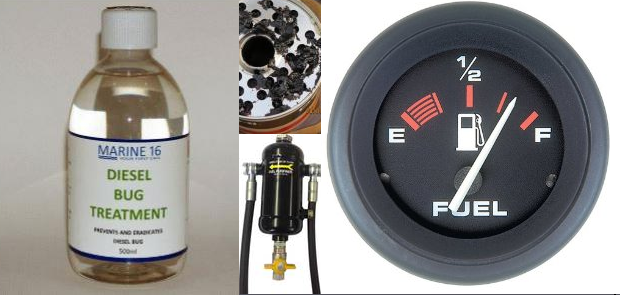

!•¡•! Digital Delights in the form of high resolution scans of Harrison Butler's boat designs are now available from HBA Chairman, John-Henry Bowden. The files are too big to attach to an email and are supplied by post on Memory Stick. These blueprints are suitable for building a full sized boat and cost £20 each for members, £30 for non-members. Any given design typically has two or three blueprints associated with it. Email John-Henry for further detail. johnhenry.and.marilyn@gmail.com
!•¡•! Boats sold recently: Watermaiden (£3,500), Chiquita (£1,500)
!•¡•! A new boating magazine, Classic Sailor, has been launched. It's a little more 'down to earth' than the more established monthly, Classic Boat, and is aimed at the sort of person with a limited budget that might aspire to own a Harrison Butler designed boat. You can 'try before you buy' with the first issue freely available from the Classic Sailor Magazine website.
!•¡•! The HBA's 2016 AGM is on Sunday 7th February at 2.30 pm at Guildford Golf Club, Surrey, GU1 2HL. Members have been notified by email with an Agenda for the meeting attached.
Going For Olympic Gold
~ Seasalter's Voyage to Brazil, 2016 ~
Jay Lawry
Seasalter is reputed to be the largest of Harrison Butler's designs ever built. She is an Aristene design launched in 1937 from the yard of JP Clausen and Sons of Birkenhead , Port Adelaide, South Australia. Her first owner was the Reverend Guy Pentreath who was, at the time, Headmaster of a prominent Boys School in Adelaide. She was well built of a mighty piece of Jarrah 18"x14" for her keel, with four garboards of Jarrah and all the remaining planking of the renowned Huon Pine. The frames were bent Swamp Gum. Two stringers of 5"x2" Oregon ran full length and the sheer clamp was 6"x2". She was rigged as a ketch with loose footed sails.
During the war years she was employed in harbour patrol duties with two soldiers with Lee Enfield 303s and a box of grenades on deck! After the war she was sold to a man who removed her elegant raised house, converted her to a cutter and added another ton and half of lead to the keel. He sailed her in the 1949 Sydney Hobart Yacht Race coming 6th out of 9 starters.
Her ownership changed many times through the 1950s and 1960s. At one point she was prepared to sail around the world nonstop by a pair of identical twins. After two false starts the plan was abandoned. She was raced extensively around the South Australian and Victorian coasts which is all part of the notoriously rough Bass Strait.
In 1986 she was bought by a New Zealander who sailed her to Fiji and Tonga on a couple of occasions before making her his home in the anchorage at Opua at the northern end of New Zealand. In 2007 there was a ferocious storm which saw Seasalter perched on a rocky shelf with her anchor embedded in her stem post and extensive damage to her forefoot. When told of the stranding the owner, who was away at the time, had a heart attack and died. Seasalter was offered to me that year as I was at the time running a boat restoration school. Although with plenty of boats of my own, I decided to take her on. I found that the clamp, stringers and deck had all been fastened with steel bolts and nails. These had caused extensive rot. I removed the hull fastenings and replaced them with bronze bolts; had new floors, hanging knees and chainplates cast in aluminium bronze; built an entirely new deck including beams, carlins and covering boards; installed a completely new interior; installed a new diesel motor and had her rewired from scratch; there are new spars and new sails and rigging.
My plan is to leave New Zealand in early 2016 to sail via Cape Horn to the Falkland Islands thence to Argentina, Uruguay and finally to Rio de Janeiro in August. After the Games I would like to sail north along the Brazilian coast, into the Caribbean and up the East coast of the United States with a possibility of reaching the UK in 2017. Seasalter is a grand old lady of 78 years with a complete makeover. She is strong and with a good pedigree and I am proud of how my restoration of her has turned out.
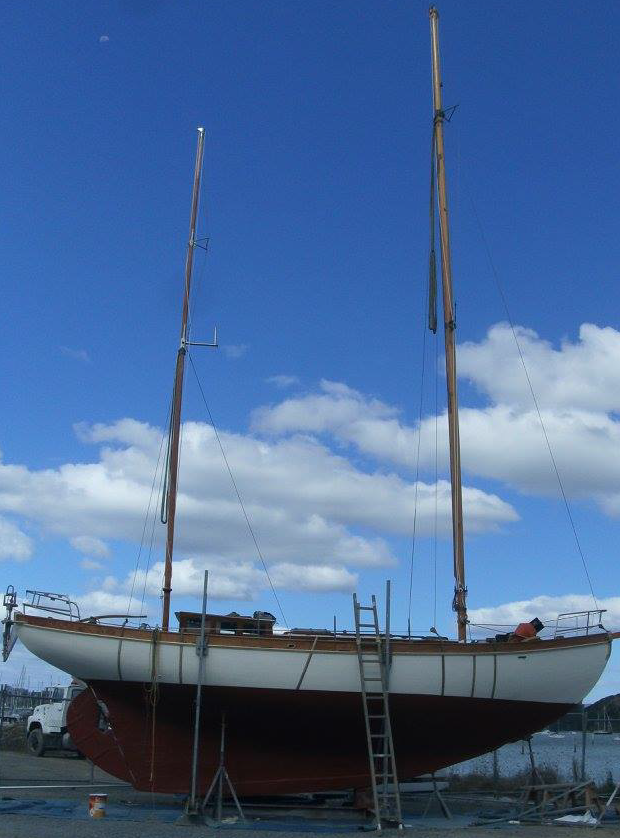
Seasalter with her masts being refitted, prior to relaunch, December 2015.
She's been ashore for the last eight years, having a major restoration.
The Boddengewässer
Myriam Spicka
The HBA's Baltic Correspondent
Although East and West Germany became reunified twenty-five years ago, it had not occurred to me until last year that this made accessible to westerners the north-eastern waters of the German coast, the so called Boddengewässer. In previous years, I and my crew had popped into some East German coastal harbours for a night, but only while speeding on to Denmark, Sweden or the northern baltic from our home port of Lübeck. For the summer of 2015 we decided to explore these passed-by waters.
Our boat, Mowa, is a Waterbug, build at Uphams of Brixham in 1954. She is derived from Harrison Butler's Zyklone design. Mowa's crew are Larissa, myself, and my daughter Katharina.
On the first day of our holiday, a Friday evening, we left Lübeck, intending to simply travel a few kilometers down river to Travemünde, and stop close to where the four masted Passat is anchored as a tourist attraction. Built in 1911 she is one of the last surviving windjammers. However, a weather-report warned us that we were experiencing our last 24 hours of favourable westerly wind, and so we pressed on out to sea, heading North-North-East on a brisk and comfortable beam reach. Following a magnificent sunset, a full moon negated the need turn on our compass light, the bright star Alpha Coronae Borealis, next to the spreader, leading the way. By early morning Gedser, a town at the southern tip of the Danish island of Falster, lay portside ahead. It took a further 16 hours before we approached the gap southwest of the island of Hiddensee and entered the cruising area we'd come to explore, the Boddengewässer.
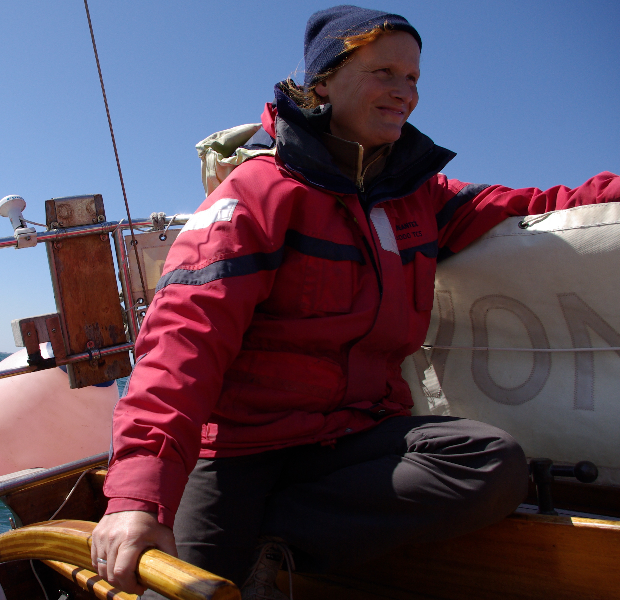
Myriam Spicka, at the helm of her Harrison Butler derived Waterbug, Mowa
What we found initially were quiet anchorages on the Rügen coast (Zickersee, Glewitzer Wiek), little harbours with excellent food (I recommend The Schillings Gasthof resteraunt in the town of Schaprode), thriving cities (Stralsund) and wonderful scenery.
We sailed further south to the Greifswalder Bodden and into the Peenestrom. Here we discovered a beautiful and remote landscape speckled with rusty World War II Russian Army scrap and impoverished towns, but kind and welcoming people. The navigation needed care as there were often big piles of stones in the middle of the otherwise attractive bays and inlets.
The harbours of the Achterwasser were even quieter; this lagoon in the middle of a low mountain range reminded me of sailing the River Rhine. A few miles ahead was the Polish frontier. We decided to sail back and take a closer look at the Greifswalder Bodden, a more sailboat friendly area. On a fresh breeze, Mowa gave her best, averaging 5.8 knots on a day-long beam reach, the fastest she's ever run. We had the feeling that she was happy to leave the motorboat stewen, sedate waters of the Peenestrom in her wake.
Homeward bound, we set course for the Baltic Sea north of Hiddensee. On the swell left by a mid-summer gale we bobbed up and down on our way to Warnemünde and had a last stop-over behind the island, Poel. Here we were rewarded by the pleasure of dropping Mowa's anchor in an idyllic paradise. Another warm evening of good food and wine, reading, playing cards, and laughing. A Carribbean sunset convinced us that the Boddengewässer, and especially the Greifswalder Bodden and the waters around Hiddensee, is a summer hideway in a class of its own.
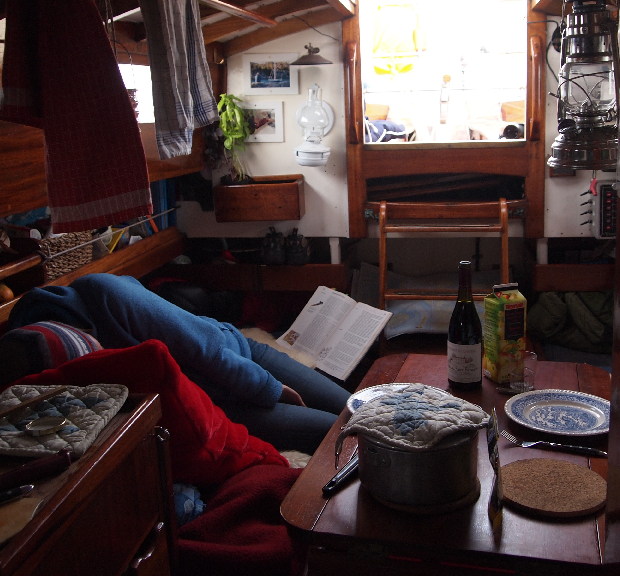
Life aboard Mowa.
“Good food and wine, reading, playing cards, and laughter”
The Waterbug - A Derived Design ?
Martin Hansen
The HBA's Webmaster & Journal Editor
One of the pleasures of being HBA webmaster is that I'm often the first point of contact for owners who suspect that their boat is designed by Harrison Butler. Over the past year, four such contacts involved a Waterbug, a design built by the Uphams' Boatyard in Brixham, South Devon, mostly in the 1950s. Another two Waterbugs were already known to the Association and, indeed, already had a page each on “The Boats” section of the website. It was immediately clear that the Waterbug design was not authentic Harrison Butler but could it be considered a derived design ? How many of these Waterbugs had been built ? I decided to investigate.
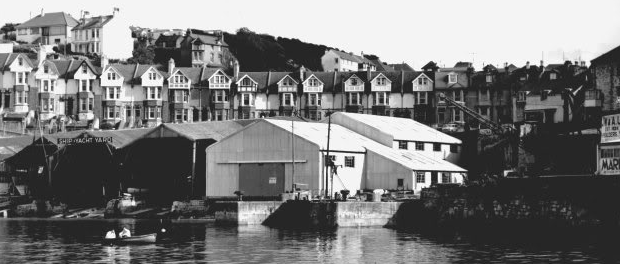
Uphams' Ship & Yacht Yard, Brixham, Devon, in the early 1950s
To be clear, the starting point of my investigation is to repeat that the Waterbugs are not authentic Harrison Butler Zyklon design boats. If they are related, it has to be argued that Stuart Upham, designer for Uphams yard before World War II, was aware of the Zyklon design, liked it, but thought he would have a more sellable boat if he made some major modifications, in particular making it bigger so as to have a 4 berth, rather than a 2 berth, boat. In the late 1930s the Zyklon was capturing several people's imagination. In particular, Captain Watts oversaw the production of around 50 Zyklons, the Z4s, in 1938 and 1939. The Zyklon design was published in October 1937, the first Waterbug, Grackle, built in 1938. The timings allow for the Waterbug to be derived from the Zyklon.
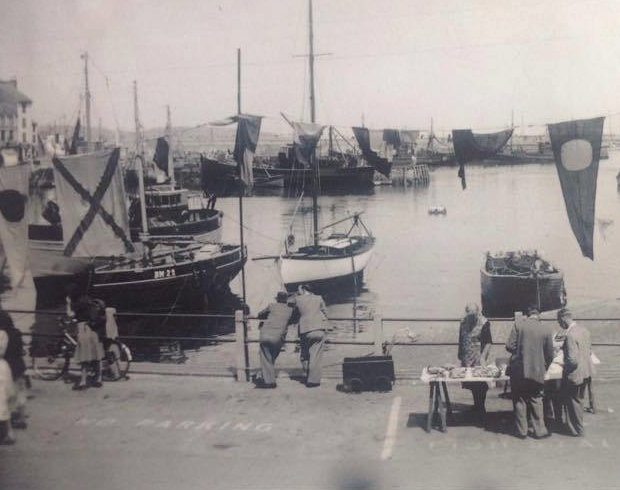
A view of Brixham harbour from the late 1940s, with a Waterbug, centre, clearly visible.
Given that we are looking for a link between the Waterbugs and the Zyklon design (that may not exist) let's see what can be done to add weight to the conjectured connection. Take the lines of the Zyklon and stretch them by 2 inches for every foot to force the Zyklon to have roughly the Waterbug's dimensions. To cope with the extra weight in the cockpit, a greater beam aft is needed. This gives the Waterbug a stern that's different to that of the Zyklon.
In the image below, the lines of the Waterbug Frangipani are superimposed onto the lines of the Zyklon Z4 from Harrison Butler's book, “Cruising Yachts; Design and Performance”, having applied the 2 inches per foot stretch. Aside from the flatter sheer, there is a very good match until the seventh rib. The bow profile, angle of the transom and midships section are spot-on, and the difference in the underwater profile can be accounted for by the need to design more rocker in the keel to accommodate the extra ballast required. The Waterbug even retains the Zyklon's very broad keel (17inches at its widest), that builders complained about because of the waste in shaping the keelson.
Frangipani's custodian, Dominic Bailey, is responsible for this work in matching up the two designs.
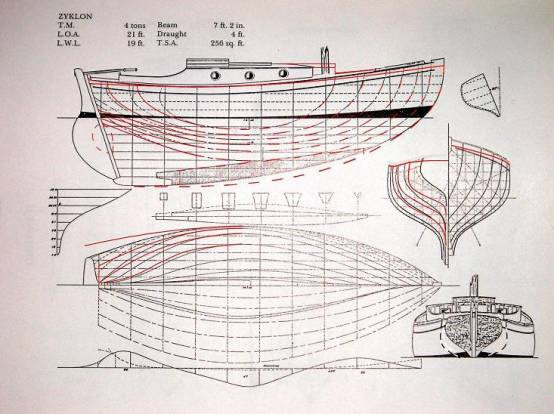
A comparison of the Uphams' Waterbug design with that of Harrison Butler's Zyklon.
Red lines are of the Waterbug, superimposed upon the Zyklon's in black.
Image constructed by Frangipani's custodian, Dominic Bailey.
Of course, it is possible that both designers drew inspiration independently from the Falmouth Quay Punt. The Zyklon is smaller - the Waterbugs of similar size. Also into the mix is the fact that Uphams built Trana in 1938, a boat believed to be an authentic implimentation of Harrison Butler's Omega design of 1938.
Amidst the possibilities and speculation is the secondary evidence that the Waterbugs are indeed based upon a Harrison Butler design; the simple fact that a few of them, immediately they were built, were inserted into the Lloyd's register with Harrison Butler credited as the designer.
I concluded my investigations knowing of sixteen Waterbugs. Each now has its own page on the HBA website where further information about the individual boats may be found. In date order, the Waterbugs are;
Grakle (1938), Night Wind (1939), Veritia (1939), Whimsical (1951), Arlyn (1954), Cockatoo (1954), Friar Tuck (1954), Kara Third (1954), Mowa (1954), Frangipani (1957), Rondelle (1957), Uldra (1957), Ballon (1959), Melissa B (1959), Sionnachan (1959) and Felicity Al (1960)
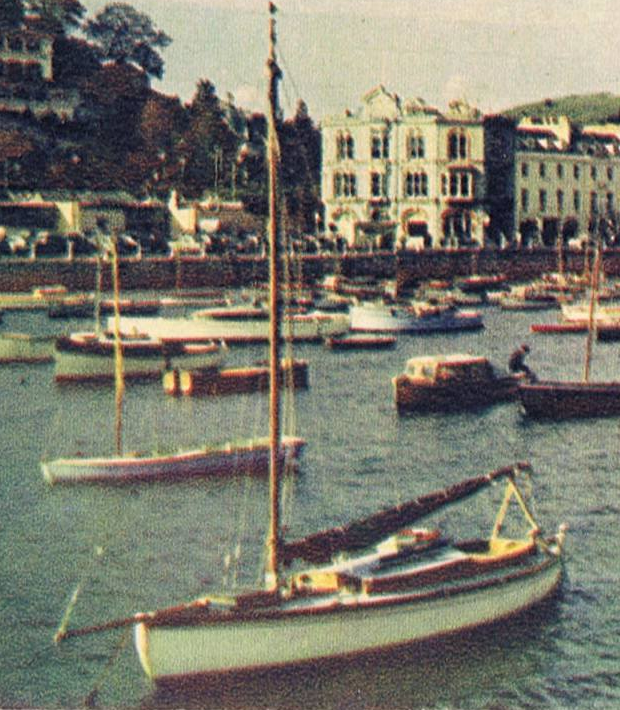
The above image is from an old (1960s) postcard of Torquay harbour.
I suspect it's of one of the earlier Waterbugs as the chain plates are on the outside
of the hull and the coach roof stops before the mast.
Memories of Little Kingfisher
Richard Best
My knowledge of Kingfisher, as she was called then, stems from my father, Tom Best, and the stories he told to the family when I was a child. He had happy memories of her, having proposed to my mother and subsequently honeymooning on board. Times are impossible to sort out: she was owned by John Carter, my father's best friend; their cruise to Svedborg, on the Baltic coast of Denmark, was in 1933, and I have the log of that cruise, which won the Doubleday cup for the best cruise log submitted by a member of the United Hospitals Sailing Club. Alas, John was killed when his submarine sunk; he left Kingfisher to my father in his will.
Here the years confuse: father told me that after the war Kingfisher was sent back from the Baltic (with a bill for about five pounds for maintenance!) to the Pool of London; father was by then a GP in Harrogate, and quite unable to look after her and, I suspect, unable to afford to move her, so he must have sold her then.
Around 1975, a year after my father died, I tracked her down to Mr. Bloomfield in Woodbridge. By then she had acquired a Bermudan sloop rig. After a while he agreed to sell her to me. I had by then just met the present Mrs Best, Rose-Marie, and we spent many (mostly) happy hours scraping off paint and varnish, and redoing the same - rather a nice red to the hull !
I planned, with my experience limited to steering , pulling on jib sheets, with the occasional brave foray to a spinnaker, to sail from Woodbridge down the River Deben, pop out to sea, and then sail past Felixstowe on the Orwell and up to Wolverstone. The arrogance of the young ! Of tides, winds, and navigation I knew nothing. Also nothing about sandbanks: we ended our trip on one after about twenty minutes and needed rescuing.
We did, on another occassion, get to Wolverstone, her home port for many subsequent years, and had happy times there, given that, with a sloop rig, the weather helm slowed progress. We couldn't afford new rigging, sails or engine, so we only set forth when wind and tide were likely to bring us back. Poor Kingfisher; one stormy New Years Eve she was sunk at her mooring on the River Orwell by the ferry to Denmark, which had veered out of the channel. The hulk, lying on the shore, was seen by a man I had asked to transport her to the Thames near Wargrave (I have no idea why now), but at any rate he liked the boat and bought her from me with the intention of restoring her in his back garden, which he did. That was the end of my family's time with Kingfisher. It is good to see her, now renamed Little Kingfisher, still going strong.
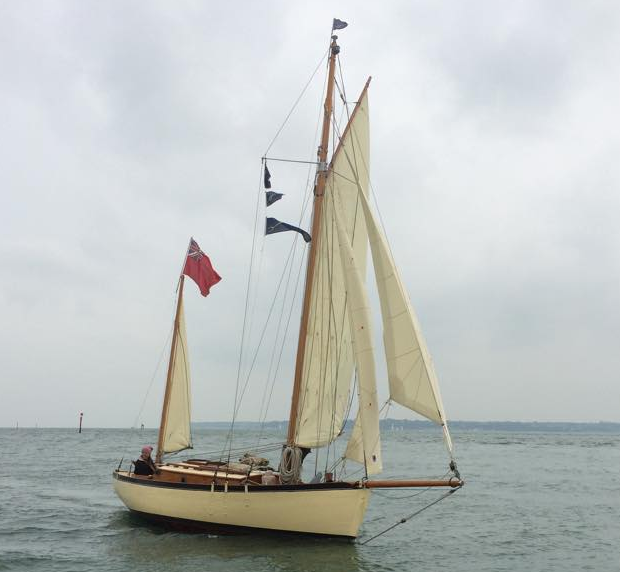
Kingfisher under sail in the Solent, on her way to the HBA's Laying Up Supper
at the Royal Southampton Yacht Club Gins Farm Base, on the Beaulieu River.
Eight boats, and twenty-six people, gathered for the event on 10th and 11th October 2015.
The boats were Askadil, Cobber, Destina, Lindy II,
Mischief III, Sabrina, Vindilis and Little Kingfisher.
A collection of photographs from the event will be on the HBA website shortly.
The above photograph of Little Kingfisher is by Susie Thomson from aboard Destina.

Cyclone : Cyclone Design : 1941 : Netherlands : £11,000
Jane : Bogle Design : 1939 : Cornwall, UK : £10,000
Jolanda : Omega Design : 1996 : Germany : £25,000
June : Z4 : 1939 : Scotland : £7,500 (open to offers)
La Bonne : Nursery Class : 1919 : Devon, UK : £POA
Saltwind : Z4 : 1940 : Spain : £16,000
Senorita : Cyclone II Design : 1934 : New Zealand : £4,000
Tamaroa : Thuella Design : 1973 : £9,000
Thule : Yonne Design : 1934 : Netherlands : £15,000 -£18,000
Witte Walvis : Z4 : 1939 : Netherlands : £5,000
Zebedee : Z4 : 1938 : Ireland : £4,750
Zephon : Z4 : 1950 : Shetland, UK : £4,500
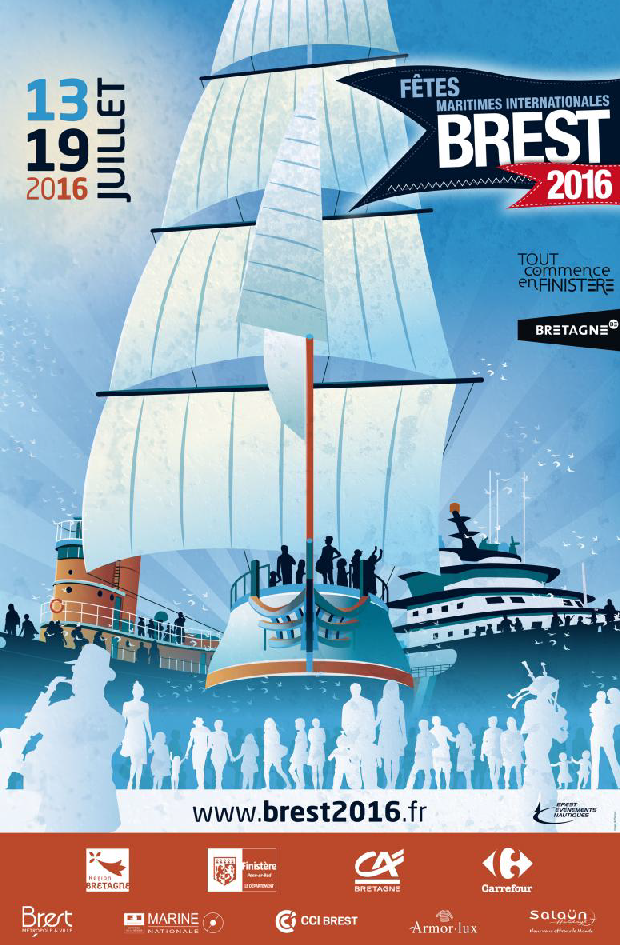

| |